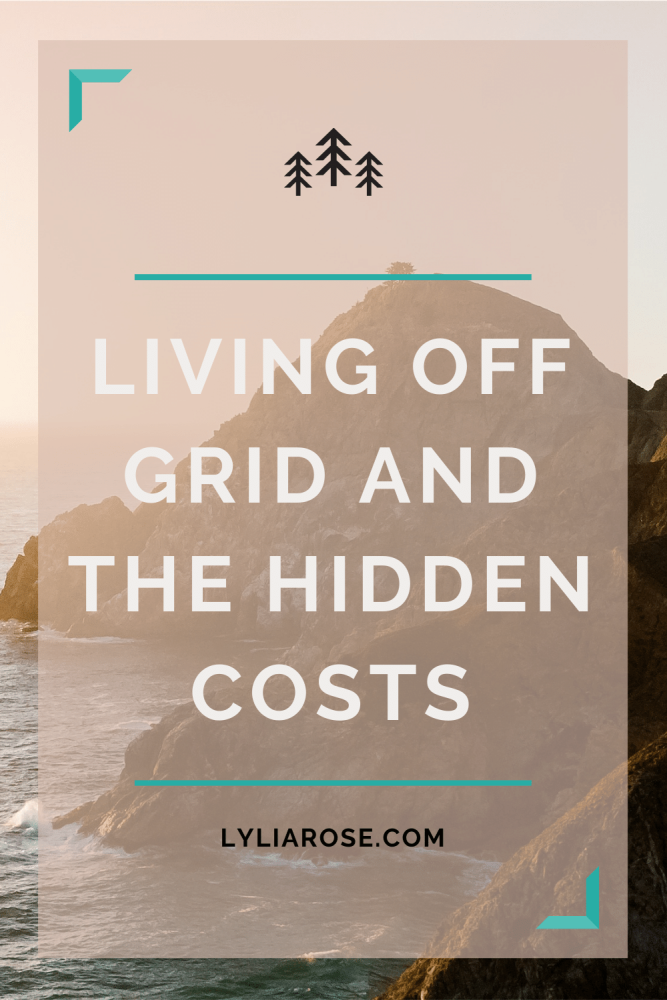Living off grid and the hidden costs
Posted on
Living off the grid is not as free as it seems. There are hidden costs that you might not be aware of. Learn more about living off the grid and the potential hidden costs in this blog post.

With everything that has been going on in the world in recent years, the idea of a simpler lifestyle with less financial ties that’s also kinder to the planet becomes more and more appealing.
It’s something my husband and I have regularly discussed, especially being avid watchers of the Ben Fogle show ‘Lives in the Wild’ for the past decade. My brother in law has even featured on the show and has been living off grid since around 2019!
If it were just me and my husband, we’d be gone in an instant! We’d sell up, move to a warmer climate where being sustainable, living off our own land and growing our own food yearlong is an option. This would be after we’ve travelled the world in a van, of course! However, we have two primary school children as I write this and we wouldn’t want to take away their schooling.
There’s an option to homeschool, but we both work full time online (we can do this remotely) so we wouldn’t be able to dedicate the time and attention needed to successfully school our children ourselves.
It’s still an option for when the children are older so we’ll see what happens in the future!
However, having discussed it quite a lot with my husband we realise that the appeal of living off the grid is often seen as a money saving solution (as well as a simpler, more eco-friendly lifestyle), but the reality is it can be quite expensive to go off-grid! Perhaps a lot more expensive than you might first think!
Whilst it can save money in the longterm there are many upfront costs to creating an offgrid lifestyle which makes this sort of lifestyle unattainable to the majority of people.
Living off grid and the costs involved
According to the Off Grid Permaculture website “The average cost of moving off grid is $101,087 with a low value of $12,447 and a high of $463,260. Typical monthly costs are between $35.42 and $2,264.” Quite a variation and I’m certain it all depends on your location and picking the ideal climate. So what are some of the costs required for going off grid? Let’s explore.
-
Land
First, you need some land! Costs for land can vary significantly between areas and countries from the tens of thousands to the hundreds of thousands!
-
Accomodation
Next, you need a home! Maybe the land already has a building suitable, or you may need to renovate an existing building or even build something from scratch. Costs here will again vary depending on what is already on the land or how you plan to build a home, but i’s likely there will be some monetary investment needed here to create a suitable living space. It also depends on how much you can do yourself and how many contractors you may need to hire.
-
Electricity
The appeal of living off the grid for many is the idea of not relying on any third party services or society for your needs. It’s the idea of being able to live self-sufficiently without outside help. Many people living off-grid still like the benefit of electricity to charge phones, use appliances and so on, so there needs to be an energy source to create electircity such as solar panels.
These can be very costly to buy upfront and can cost well into the thousands, or even tens of thousands depending on your location and the amount of light/sun you receive. You’ll likely want a battery too for storing any unused power that is generated so its not wasted.
The cost here will all depend on your location. A warmer climate with lots of sun and light nights will reduce your need for using so much electricity, plus you’ll be able to easily generate more.
Windpower and hydropower are also options that could be better suited to your climate, or used as backup solutions.
Once set up, you can generate your own electricity and have no ongoing costs unless there are maintenance costs.
-
Water
You can’t survive without water so you need a water source. If you have a spring nearby then you can source water from the spring using a pump system and piping to your off grid home. Land with springs flowing on them are going to be more desirable and more expensive than land without.
You can choose to dig a well. According to Home Advisor in the US “Drilling a well costs $5,500 for an average depth of 150 feet. Most projects range between $1,500 and $12,000.” Then you’ll need a pump to get the water from the well.
The cheapest method is likely to be harvesting rainwater, however it’s not always safe to use as drinking water, so you need to do your research. It’s still great as water for washing and watering plants, even if you can’t drink it.
Once set up, there are just maintenance costs to consider when needed.
-
Heating
In most places you will need some form of heating for winter months or cold nights. There are many options for heating such as having a gas or oil tank installed and refilled when necessary, as well as using wood fuel in log burners or stoves. If you have land with a decent supply of wood then you could potentially self sustain, but it’s most likely you’ll need to invest in some form of heating and this will have an ongoing cost. The price will vary on your climate.
-
Food
Obviously you will need food! Many people like to live off-grid to become more self-sufficient and provide their own food. You’ll need to live in a suitable climate to grow sufficient food all year long and live off the land. This will be much harder to do in locations with long, cold winters. It is possible, but you’ll need to invest upfront in a lot of suitable growing equipment and large polytunnels/greenhouses/lamps, etc. Otherwise, you’ll need to budget each month for food and be able to visit farmers markets/supermarkets to source the food you need.
-
Car insurance and car costs
If you plan to keep a car then you will need to factor in car insurance and car mainenence costs. There are special car insurance providers that offer deals if you drive less than 25 miles a day or minimally, so you can make a saving if you don’t use your car often. You’ll also need to maintain the car and factor in any annual services it may need to keep it roadworthy and legal to drive when you need to.
-
Home insurance
Home insurance is also worth considering depending on the type of home you live in off-grid and its value to you. What if your entire house was destroyed in a fire for example? Could you start all over again from scratch without an insurance payout?
-
Other bills: phone, internet
Could you go without your phone and the internet, even if you were living off-grid? It’s unlikely you’d want to cut all your communication methods, so it’s highly likely you will need to pay for a monthly phone bill at the very least and/or an internet connection. If you need to work online or plan to find ways to make money at home whilst living off grid then you're going to need the internet. Unfortunately there’s no way of getting this for free!
A lot to consider if you want to go off grid
As you can begin to see, there are a lot of costs to consider when going off grid. Realistically you do need some money to set up your off grid lifestyle successfully. If you don’t have a lump sum of money in the bank, then you will also need to continue working or having an income stream to provide money to set up your off grid lifestyle or to continue funding monthly costs such as food and the other bills mentioned above.
It’s an amazing way to live, once set up, but it will require some financial investment.
Looking for ways to save money? Check out my massive money-saving tips section and find some great deals on my voucher codes and free money pages!
